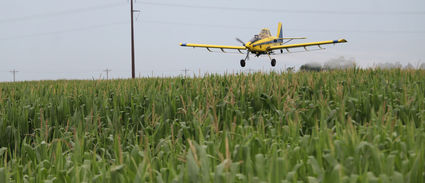Drought conditions creep into region
Local counties range from abnormally dry to moderate drought
August 6, 2020
Northwest Iowa could use a drink.
Dry conditions have expanded across the region in recent weeks thanks to a lack of rain in July. Though the situation isn't dire for local crops right now, precipitation is needed in the near future.
"For the most part, things are still looking pretty good," said ISU Extension & Outreach field agronomist Joel DeJong, who serves nine northwest Iowa counties including O'Brien. "A rain would be great, don't get me wrong, but they're hanging in there."
According to the latest U.S. Drought Monitor report, a little more than half of O'Brien County is facing moderate drought conditions with the other portion classified as moderately dry. The same is true to the east in Clay County.
DeJong said the farther north he goes in his territory, the better fields look.
"Sandier soils are having some difficulty," he said. "Being somewhat short on moisture does always impact yield potential, but we still have time for rain to make a positive impact on yields."
Portions of Sioux, Plymouth and Cherokee counties are facing severe drought conditions. Fourteen other counties in west central Iowa are also under the same classification.
DeJong said recent cool temperatures have helped corn and soybeans weather the dry stretch.
"Daily moisture demand is significantly lower in the 70's than in the 80's and 90's, so if we're going to be a little short on precip, cooler weather really isn't a bad thing right now," he explained.
According to the latest crop progress and condition report by the Iowa Department of Agriculture, topsoil moisture levels rated 14 percent very short, 33 percent short, 51 percent adequate and 2 percent surplus. Northwest, west central and central Iowa all report topsoil moisture supplies are mostly short to very short. Subsoil moisture levels rated 10 percent very short, 31 percent short, 57 percent adequate and 2 percent surplus.
Corn silking or beyond reached 95 percent, two weeks ahead of the previous year and five days ahead of the five-year average. Corn in the dough stage or beyond reached 44 percent, 10 days ahead of the previous year and four days ahead of the average. Corn condition declined to 73 percent good to excellent.
Soybeans blooming reached 91 percent, two weeks ahead of last year and six days ahead of average. Soybeans setting pods reached 70 percent, 16 days ahead of last year and six days ahead of average. Soybean condition also fell to 73 percent good to excellent.
With August's arrival, DeYong hoped for some wet forecasts.
"The sooner the better," he said. "A good shot of rain is definitely going to have a positive impact on yields."


